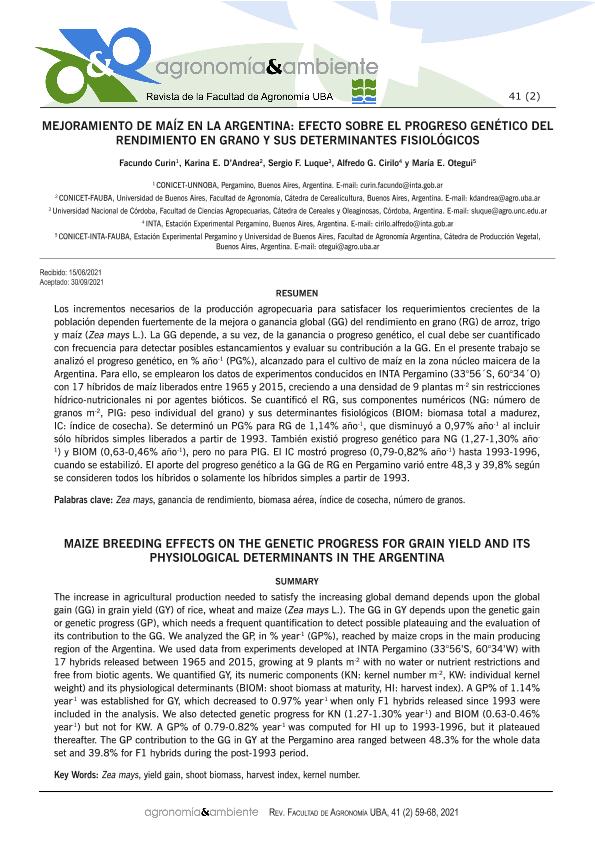Artículo
Los incrementos necesarios de la producción agropecuaria para satisfacer los requerimientos crecientes de la población dependen fuertemente de la mejora o ganancia global (GG) del rendimiento en grano (RG) de arroz, trigo y maíz (Zea mays L.). La GG depende, a su vez, de la ganancia o progreso genético, el cual debe ser cuantificado con frecuencia para detectar posibles estancamientos y evaluar su contribución a la GG. En el presente trabajo se analizó el progreso genético, en % año-1 (PG%), alcanzado para el cultivo de maíz en la zona núcleo maicera de la Argentina. Para ello, se emplearon los datos de experimentos conducidos en INTA Pergamino (33°56´S, 60°34´O) con 17 híbridos de maíz liberados entre 1965 y 2015, creciendo a una densidad de 9 plantas m-2 sin restricciones hídrico-nutricionales ni por agentes bióticos. Se cuantificó el RG, sus componentes numéricos (NG: número de granos m-2, PIG: peso individual del grano) y sus determinantes fisiológicos (BIOM: biomasa total a madurez, IC: índice de cosecha). Se determinó un PG% para RG de 1,14% año-1, que disminuyó a 0,97% año-1 al incluir sólo híbridos simples liberados a partir de 1993. También existió progreso genético para NG (1,27-1,30% año1) y BIOM (0,63-0,46% año-1), pero no para PIG. El IC mostró progreso (0,79-0,82% año-1) hasta 1993-1996, cuando se estabilizó. El aporte del progreso genético a la GG de RG en Pergamino varió entre 48,3 y 39,8% según se consideren todos los híbridos o solamente los híbridos simples a partir de 1993. The increase in agricultural production needed to satisfy the increasing global demand depends upon the global gain (GG) in grain yield (GY) of rice, wheat and maize (Zea mays L.). The GG in GY depends upon the genetic gain or genetic progress (GP), which needs a frequent quantification to detect possible plateauing and the evaluation of its contribution to the GG. We analyzed the GP, in % year-1 (GP%), reached by maize crops in the main producing region of the Argentina. We used data from experiments developed at INTA Pergamino (33°56’S, 60°34’W) with 17 hybrids released between 1965 and 2015, growing at 9 plants m-2 with no water or nutrient restrictions and free from biotic agents. We quantified GY, its numeric components (KN: kernel number m-2, KW: individual kernel weight) and its physiological determinants (BIOM: shoot biomass at maturity, HI: harvest index). A GP% of 1.14% year-1 was established for GY, which decreased to 0.97% year-1 when only F1 hybrids released since 1993 were included in the analysis. We also detected genetic progress for KN (1.27-1.30% year-1) and BIOM (0.63-0.46% year-1) but not for KW. A GP% of 0.79-0.82% year-1 was computed for HI up to 1993-1996, but it plateaued thereafter. The GP contribution to the GG in GY at the Pergamino area ranged between 48.3% for the whole data set and 39.8% for F1 hybrids during the post-1993 period.
Mejoramiento de maíz en la Argentina: efecto sobre el progreso genético del rendimiento en grano y sus determinantes fisiológicos
Título:
Maize breeding effects on the genetic progress for grain yield and its physiological determinants in the Argentina
Curin, Facundo ; D'andrea, Karina Elizabeth
; D'andrea, Karina Elizabeth ; Luque, Sergio Fernando; Cirilo, Alfredo Gabriel; Otegui, Maria Elena
; Luque, Sergio Fernando; Cirilo, Alfredo Gabriel; Otegui, Maria Elena
 ; D'andrea, Karina Elizabeth
; D'andrea, Karina Elizabeth ; Luque, Sergio Fernando; Cirilo, Alfredo Gabriel; Otegui, Maria Elena
; Luque, Sergio Fernando; Cirilo, Alfredo Gabriel; Otegui, Maria Elena
Fecha de publicación:
10/2021
Editorial:
Universidad de Buenos Aires. Facultad de Agronomía
Revista:
Agronomía & Ambiente
ISSN:
2344-9039
e-ISSN:
2314-2243
Idioma:
Español
Tipo de recurso:
Artículo publicado
Clasificación temática:
Resumen
Archivos asociados
Licencia
Identificadores
Colecciones
Articulos(OCA PQUE. CENTENARIO)
Articulos de OFICINA DE COORDINACION ADMINISTRATIVA PQUE. CENTENARIO
Articulos de OFICINA DE COORDINACION ADMINISTRATIVA PQUE. CENTENARIO
Citación
Curin, Facundo; D'andrea, Karina Elizabeth; Luque, Sergio Fernando; Cirilo, Alfredo Gabriel; Otegui, Maria Elena; Mejoramiento de maíz en la Argentina: efecto sobre el progreso genético del rendimiento en grano y sus determinantes fisiológicos; Universidad de Buenos Aires. Facultad de Agronomía; Agronomía & Ambiente; 41; 2; 10-2021; 59-68
Compartir



